How's Your Sugar? - Promoting Wellness and Education for Aboriginal Community
VerifiedAdded on 2023/03/17
|13
|3068
|90
AI Summary
This article discusses the web-based initiative, How's Your Sugar?, which aims to provide culturally safe data and education to the Aboriginal community for the prevention and management of diabetes. It explores the high prevalence of type 2 diabetes among the Aboriginal and Torres Strait Islander people in Australia and highlights the importance of education and promoting a healthy lifestyle. The article also discusses the current status of the disease in the community and suggests actions and prevention strategies to address the issue.
Contribute Materials
Your contribution can guide someone’s learning journey. Share your
documents today.
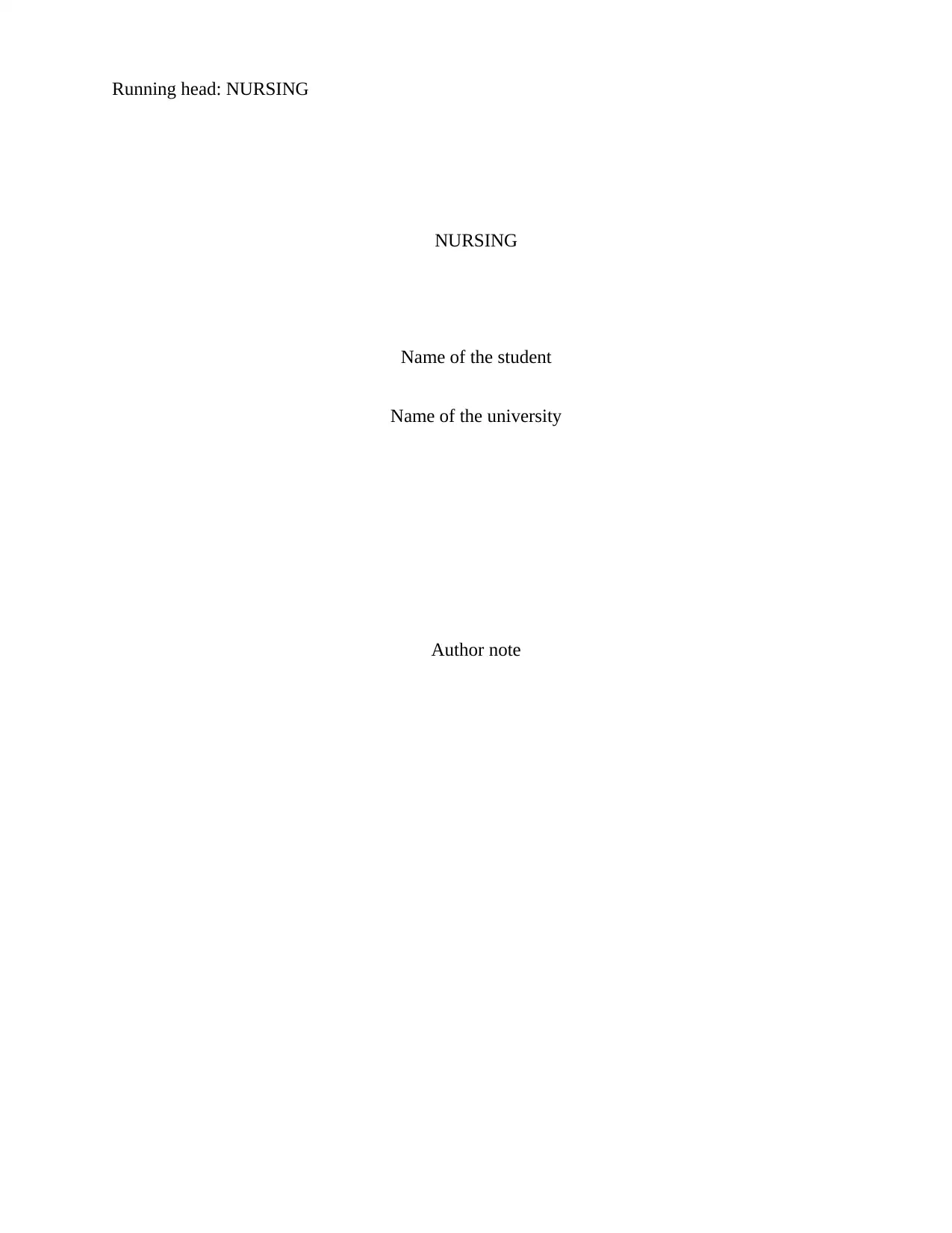
Running head: NURSING
NURSING
Name of the student
Name of the university
Author note
NURSING
Name of the student
Name of the university
Author note
Secure Best Marks with AI Grader
Need help grading? Try our AI Grader for instant feedback on your assignments.

NURSING 1
Introduction
The General Assembly of the United Nations proclaimed the decade of the actions
regarding the nutrition in the recognition for the requirement for the eradication all the forms of
malnutrition and over nutrition throughout the world. Diabetes has been one of the rapidly
growing chronic illness or disease which has reached towards the global academic proportion
posing a threating challenge for the public everywhere (Dabelea et al., 2014). The aboriginal and
Torres Strait islander people residing in Australia tends to experience a disproportionately higher
level of diabetes. According to Anderson et al. (2015) the aboriginal community of people are
more likely to get affected by type 2 diabetes in the comparison with non-indigenous
Australians. In the context of the initiation of the improvement of the condition, the web page
named, “How’s your sugar?” uses narrative information regarding health as one of the vital skills
for the provision of a holistic care for the aboriginal community people in Australia. “How’s
your sugar” employs a strength based, informal based model including a peer to peer narrative
approach that aims to enhance the ability for the provision of culturally safe data to the
aboriginals through education and the promotion of wellness.
Introduction
The General Assembly of the United Nations proclaimed the decade of the actions
regarding the nutrition in the recognition for the requirement for the eradication all the forms of
malnutrition and over nutrition throughout the world. Diabetes has been one of the rapidly
growing chronic illness or disease which has reached towards the global academic proportion
posing a threating challenge for the public everywhere (Dabelea et al., 2014). The aboriginal and
Torres Strait islander people residing in Australia tends to experience a disproportionately higher
level of diabetes. According to Anderson et al. (2015) the aboriginal community of people are
more likely to get affected by type 2 diabetes in the comparison with non-indigenous
Australians. In the context of the initiation of the improvement of the condition, the web page
named, “How’s your sugar?” uses narrative information regarding health as one of the vital skills
for the provision of a holistic care for the aboriginal community people in Australia. “How’s
your sugar” employs a strength based, informal based model including a peer to peer narrative
approach that aims to enhance the ability for the provision of culturally safe data to the
aboriginals through education and the promotion of wellness.
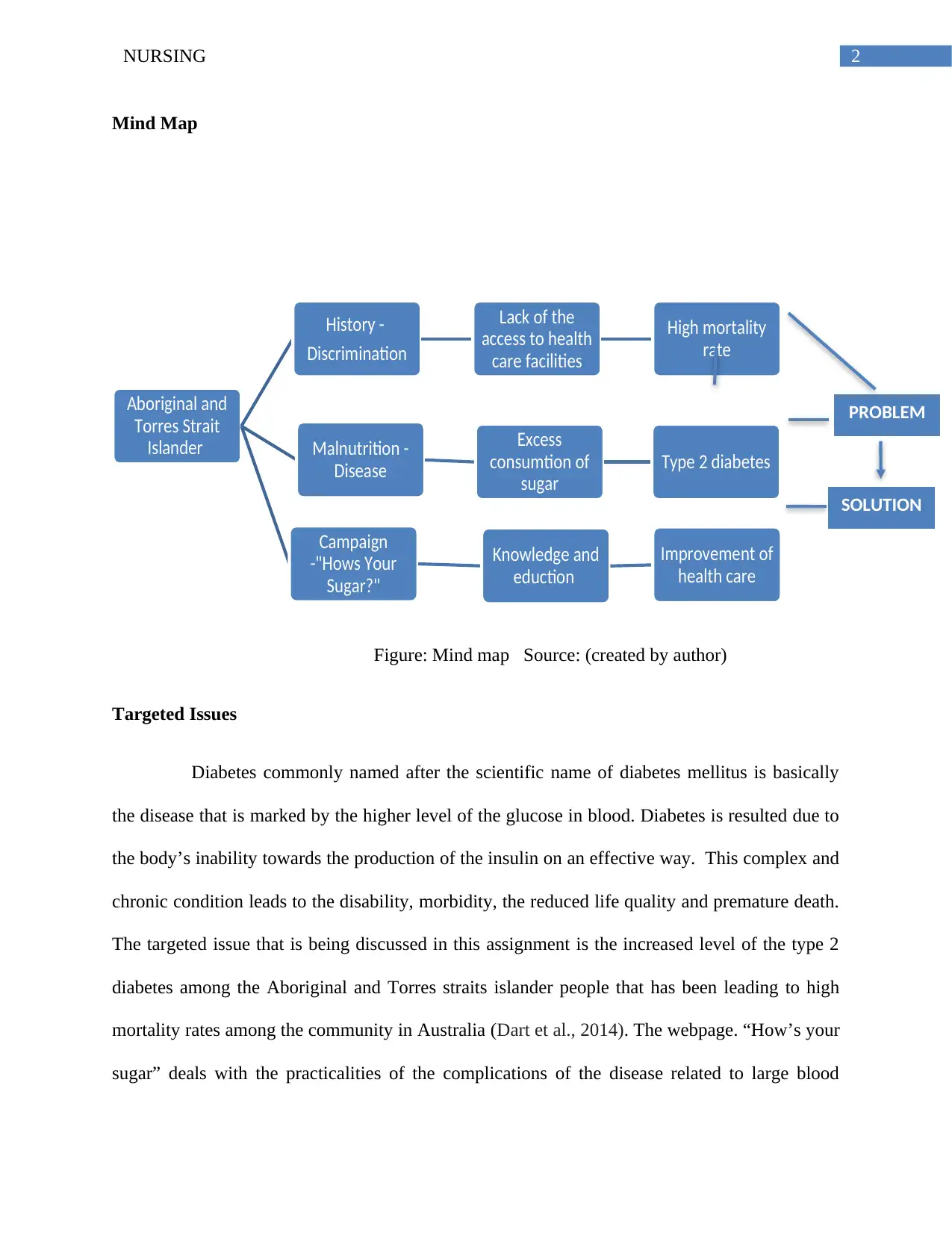
2NURSING
Mind Map
Figure: Mind map Source: (created by author)
Targeted Issues
Diabetes commonly named after the scientific name of diabetes mellitus is basically
the disease that is marked by the higher level of the glucose in blood. Diabetes is resulted due to
the body’s inability towards the production of the insulin on an effective way. This complex and
chronic condition leads to the disability, morbidity, the reduced life quality and premature death.
The targeted issue that is being discussed in this assignment is the increased level of the type 2
diabetes among the Aboriginal and Torres straits islander people that has been leading to high
mortality rates among the community in Australia (Dart et al., 2014). The webpage. “How’s your
sugar” deals with the practicalities of the complications of the disease related to large blood
Aboriginal and
Torres Strait
Islander
History -
Discrimination
Lack of the
access to health
care facilities
High mortality
rate
Malnutrition -
Disease
Excess
consumtion of
sugar
Type 2 diabetes
Campaign
-"Hows Your
Sugar?"
Knowledge and
eduction
Improvement of
health care
PROBLEM
SOLUTION
BLEM
Mind Map
Figure: Mind map Source: (created by author)
Targeted Issues
Diabetes commonly named after the scientific name of diabetes mellitus is basically
the disease that is marked by the higher level of the glucose in blood. Diabetes is resulted due to
the body’s inability towards the production of the insulin on an effective way. This complex and
chronic condition leads to the disability, morbidity, the reduced life quality and premature death.
The targeted issue that is being discussed in this assignment is the increased level of the type 2
diabetes among the Aboriginal and Torres straits islander people that has been leading to high
mortality rates among the community in Australia (Dart et al., 2014). The webpage. “How’s your
sugar” deals with the practicalities of the complications of the disease related to large blood
Aboriginal and
Torres Strait
Islander
History -
Discrimination
Lack of the
access to health
care facilities
High mortality
rate
Malnutrition -
Disease
Excess
consumtion of
sugar
Type 2 diabetes
Campaign
-"Hows Your
Sugar?"
Knowledge and
eduction
Improvement of
health care
PROBLEM
SOLUTION
BLEM
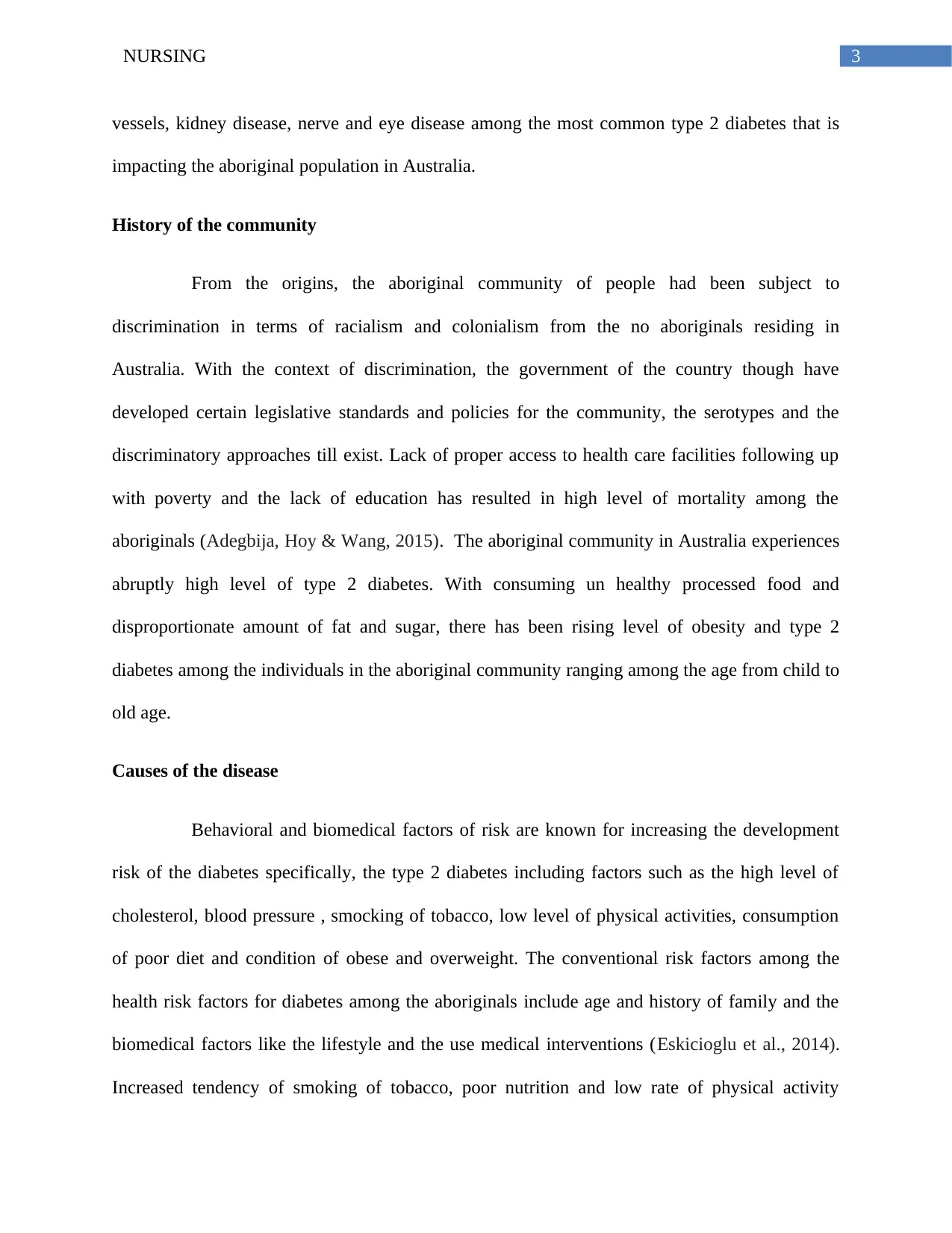
3NURSING
vessels, kidney disease, nerve and eye disease among the most common type 2 diabetes that is
impacting the aboriginal population in Australia.
History of the community
From the origins, the aboriginal community of people had been subject to
discrimination in terms of racialism and colonialism from the no aboriginals residing in
Australia. With the context of discrimination, the government of the country though have
developed certain legislative standards and policies for the community, the serotypes and the
discriminatory approaches till exist. Lack of proper access to health care facilities following up
with poverty and the lack of education has resulted in high level of mortality among the
aboriginals (Adegbija, Hoy & Wang, 2015). The aboriginal community in Australia experiences
abruptly high level of type 2 diabetes. With consuming un healthy processed food and
disproportionate amount of fat and sugar, there has been rising level of obesity and type 2
diabetes among the individuals in the aboriginal community ranging among the age from child to
old age.
Causes of the disease
Behavioral and biomedical factors of risk are known for increasing the development
risk of the diabetes specifically, the type 2 diabetes including factors such as the high level of
cholesterol, blood pressure , smocking of tobacco, low level of physical activities, consumption
of poor diet and condition of obese and overweight. The conventional risk factors among the
health risk factors for diabetes among the aboriginals include age and history of family and the
biomedical factors like the lifestyle and the use medical interventions (Eskicioglu et al., 2014).
Increased tendency of smoking of tobacco, poor nutrition and low rate of physical activity
vessels, kidney disease, nerve and eye disease among the most common type 2 diabetes that is
impacting the aboriginal population in Australia.
History of the community
From the origins, the aboriginal community of people had been subject to
discrimination in terms of racialism and colonialism from the no aboriginals residing in
Australia. With the context of discrimination, the government of the country though have
developed certain legislative standards and policies for the community, the serotypes and the
discriminatory approaches till exist. Lack of proper access to health care facilities following up
with poverty and the lack of education has resulted in high level of mortality among the
aboriginals (Adegbija, Hoy & Wang, 2015). The aboriginal community in Australia experiences
abruptly high level of type 2 diabetes. With consuming un healthy processed food and
disproportionate amount of fat and sugar, there has been rising level of obesity and type 2
diabetes among the individuals in the aboriginal community ranging among the age from child to
old age.
Causes of the disease
Behavioral and biomedical factors of risk are known for increasing the development
risk of the diabetes specifically, the type 2 diabetes including factors such as the high level of
cholesterol, blood pressure , smocking of tobacco, low level of physical activities, consumption
of poor diet and condition of obese and overweight. The conventional risk factors among the
health risk factors for diabetes among the aboriginals include age and history of family and the
biomedical factors like the lifestyle and the use medical interventions (Eskicioglu et al., 2014).
Increased tendency of smoking of tobacco, poor nutrition and low rate of physical activity
Secure Best Marks with AI Grader
Need help grading? Try our AI Grader for instant feedback on your assignments.
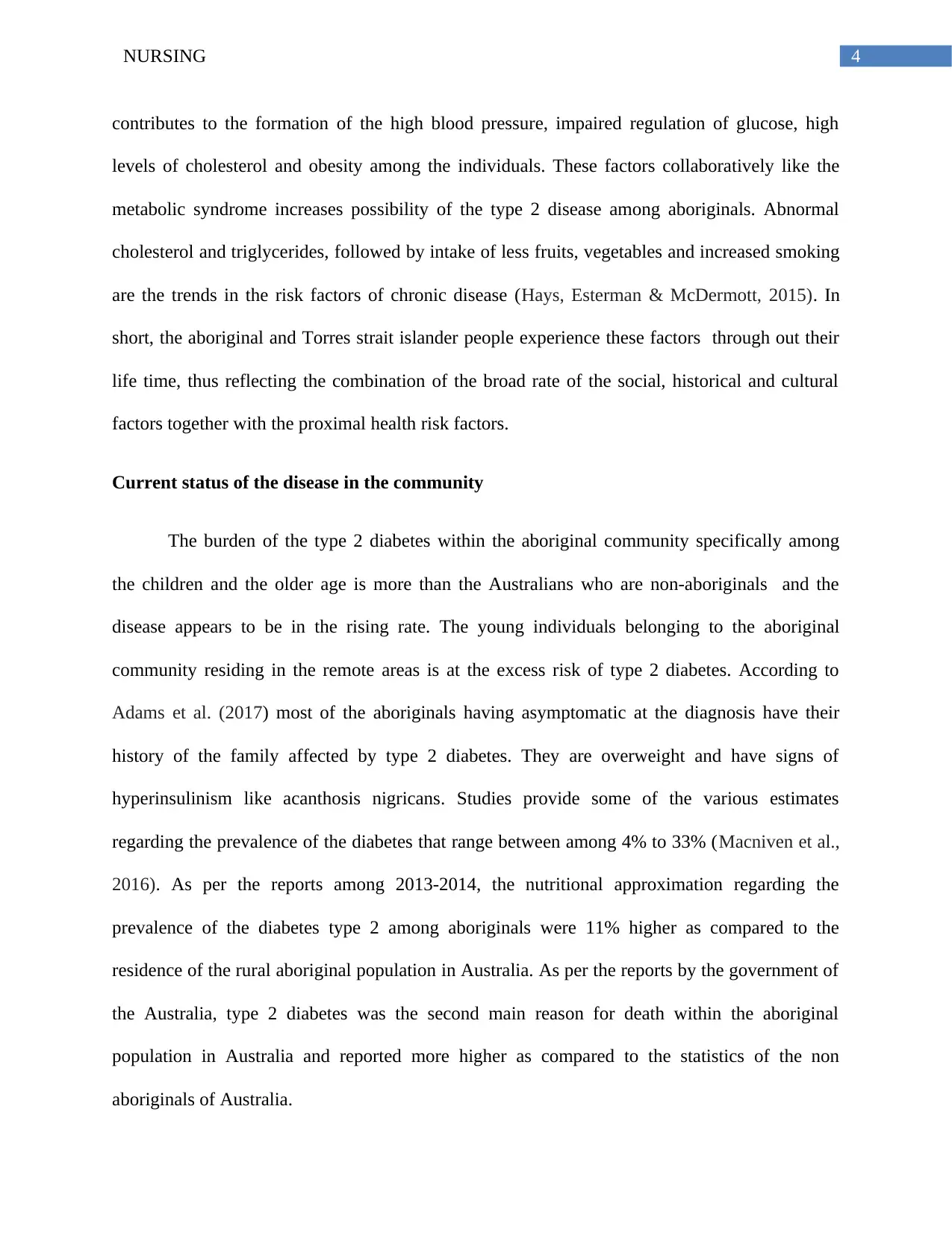
4NURSING
contributes to the formation of the high blood pressure, impaired regulation of glucose, high
levels of cholesterol and obesity among the individuals. These factors collaboratively like the
metabolic syndrome increases possibility of the type 2 disease among aboriginals. Abnormal
cholesterol and triglycerides, followed by intake of less fruits, vegetables and increased smoking
are the trends in the risk factors of chronic disease (Hays, Esterman & McDermott, 2015). In
short, the aboriginal and Torres strait islander people experience these factors through out their
life time, thus reflecting the combination of the broad rate of the social, historical and cultural
factors together with the proximal health risk factors.
Current status of the disease in the community
The burden of the type 2 diabetes within the aboriginal community specifically among
the children and the older age is more than the Australians who are non-aboriginals and the
disease appears to be in the rising rate. The young individuals belonging to the aboriginal
community residing in the remote areas is at the excess risk of type 2 diabetes. According to
Adams et al. (2017) most of the aboriginals having asymptomatic at the diagnosis have their
history of the family affected by type 2 diabetes. They are overweight and have signs of
hyperinsulinism like acanthosis nigricans. Studies provide some of the various estimates
regarding the prevalence of the diabetes that range between among 4% to 33% (Macniven et al.,
2016). As per the reports among 2013-2014, the nutritional approximation regarding the
prevalence of the diabetes type 2 among aboriginals were 11% higher as compared to the
residence of the rural aboriginal population in Australia. As per the reports by the government of
the Australia, type 2 diabetes was the second main reason for death within the aboriginal
population in Australia and reported more higher as compared to the statistics of the non
aboriginals of Australia.
contributes to the formation of the high blood pressure, impaired regulation of glucose, high
levels of cholesterol and obesity among the individuals. These factors collaboratively like the
metabolic syndrome increases possibility of the type 2 disease among aboriginals. Abnormal
cholesterol and triglycerides, followed by intake of less fruits, vegetables and increased smoking
are the trends in the risk factors of chronic disease (Hays, Esterman & McDermott, 2015). In
short, the aboriginal and Torres strait islander people experience these factors through out their
life time, thus reflecting the combination of the broad rate of the social, historical and cultural
factors together with the proximal health risk factors.
Current status of the disease in the community
The burden of the type 2 diabetes within the aboriginal community specifically among
the children and the older age is more than the Australians who are non-aboriginals and the
disease appears to be in the rising rate. The young individuals belonging to the aboriginal
community residing in the remote areas is at the excess risk of type 2 diabetes. According to
Adams et al. (2017) most of the aboriginals having asymptomatic at the diagnosis have their
history of the family affected by type 2 diabetes. They are overweight and have signs of
hyperinsulinism like acanthosis nigricans. Studies provide some of the various estimates
regarding the prevalence of the diabetes that range between among 4% to 33% (Macniven et al.,
2016). As per the reports among 2013-2014, the nutritional approximation regarding the
prevalence of the diabetes type 2 among aboriginals were 11% higher as compared to the
residence of the rural aboriginal population in Australia. As per the reports by the government of
the Australia, type 2 diabetes was the second main reason for death within the aboriginal
population in Australia and reported more higher as compared to the statistics of the non
aboriginals of Australia.
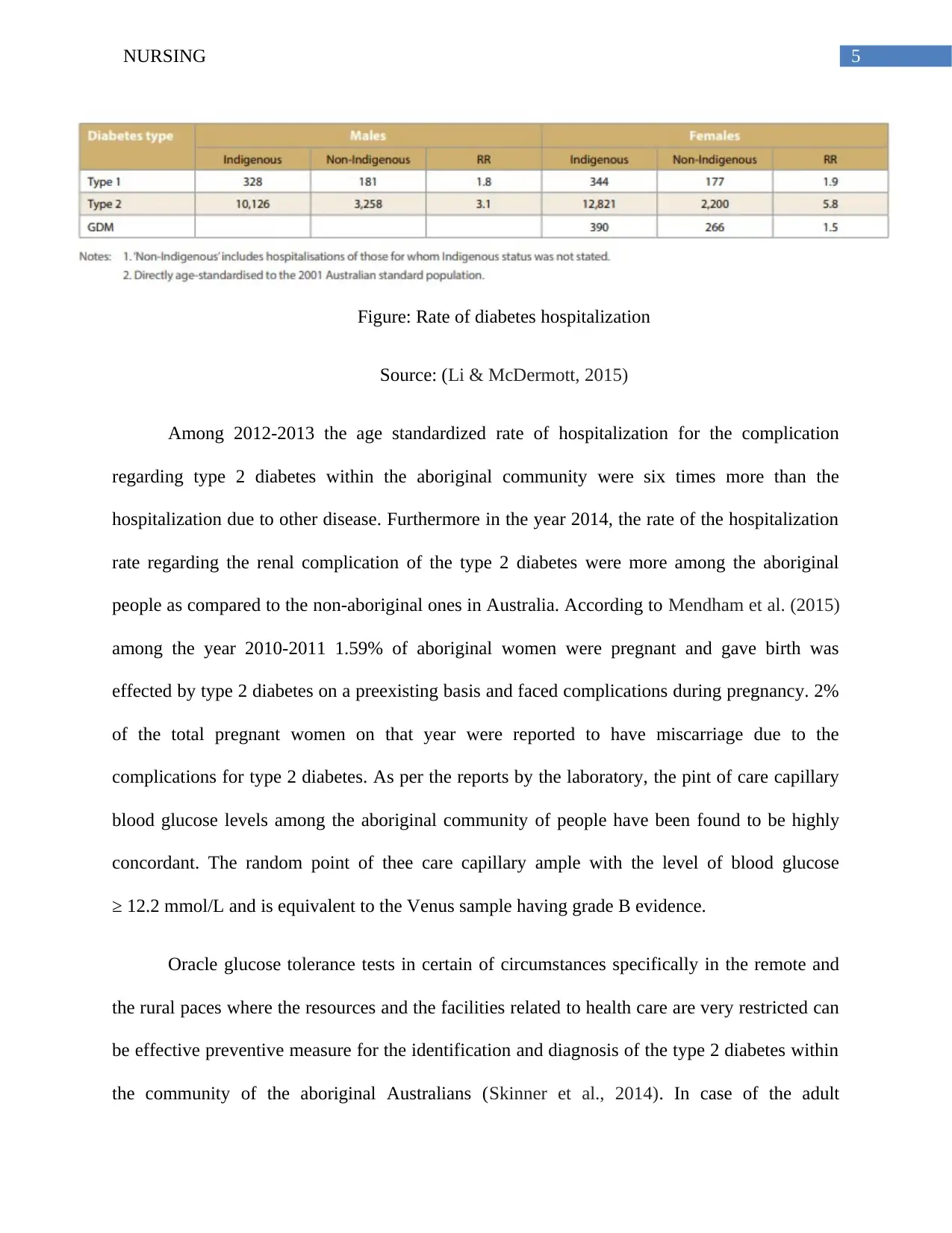
5NURSING
Figure: Rate of diabetes hospitalization
Source: (Li & McDermott, 2015)
Among 2012-2013 the age standardized rate of hospitalization for the complication
regarding type 2 diabetes within the aboriginal community were six times more than the
hospitalization due to other disease. Furthermore in the year 2014, the rate of the hospitalization
rate regarding the renal complication of the type 2 diabetes were more among the aboriginal
people as compared to the non-aboriginal ones in Australia. According to Mendham et al. (2015)
among the year 2010-2011 1.59% of aboriginal women were pregnant and gave birth was
effected by type 2 diabetes on a preexisting basis and faced complications during pregnancy. 2%
of the total pregnant women on that year were reported to have miscarriage due to the
complications for type 2 diabetes. As per the reports by the laboratory, the pint of care capillary
blood glucose levels among the aboriginal community of people have been found to be highly
concordant. The random point of thee care capillary ample with the level of blood glucose
≥ 12.2 mmol/L and is equivalent to the Venus sample having grade B evidence.
Oracle glucose tolerance tests in certain of circumstances specifically in the remote and
the rural paces where the resources and the facilities related to health care are very restricted can
be effective preventive measure for the identification and diagnosis of the type 2 diabetes within
the community of the aboriginal Australians (Skinner et al., 2014). In case of the adult
Figure: Rate of diabetes hospitalization
Source: (Li & McDermott, 2015)
Among 2012-2013 the age standardized rate of hospitalization for the complication
regarding type 2 diabetes within the aboriginal community were six times more than the
hospitalization due to other disease. Furthermore in the year 2014, the rate of the hospitalization
rate regarding the renal complication of the type 2 diabetes were more among the aboriginal
people as compared to the non-aboriginal ones in Australia. According to Mendham et al. (2015)
among the year 2010-2011 1.59% of aboriginal women were pregnant and gave birth was
effected by type 2 diabetes on a preexisting basis and faced complications during pregnancy. 2%
of the total pregnant women on that year were reported to have miscarriage due to the
complications for type 2 diabetes. As per the reports by the laboratory, the pint of care capillary
blood glucose levels among the aboriginal community of people have been found to be highly
concordant. The random point of thee care capillary ample with the level of blood glucose
≥ 12.2 mmol/L and is equivalent to the Venus sample having grade B evidence.
Oracle glucose tolerance tests in certain of circumstances specifically in the remote and
the rural paces where the resources and the facilities related to health care are very restricted can
be effective preventive measure for the identification and diagnosis of the type 2 diabetes within
the community of the aboriginal Australians (Skinner et al., 2014). In case of the adult
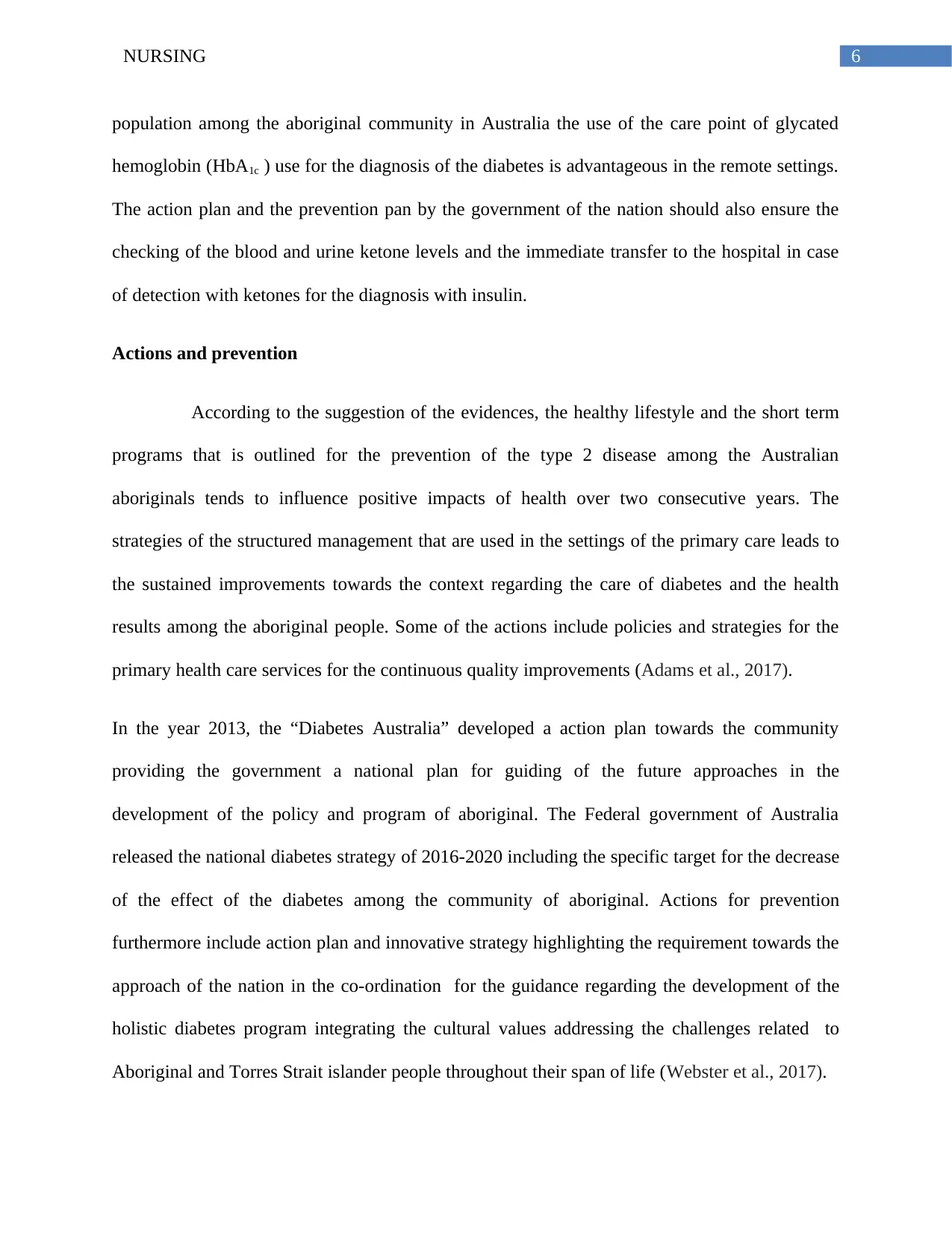
6NURSING
population among the aboriginal community in Australia the use of the care point of glycated
hemoglobin (HbA1c ) use for the diagnosis of the diabetes is advantageous in the remote settings.
The action plan and the prevention pan by the government of the nation should also ensure the
checking of the blood and urine ketone levels and the immediate transfer to the hospital in case
of detection with ketones for the diagnosis with insulin.
Actions and prevention
According to the suggestion of the evidences, the healthy lifestyle and the short term
programs that is outlined for the prevention of the type 2 disease among the Australian
aboriginals tends to influence positive impacts of health over two consecutive years. The
strategies of the structured management that are used in the settings of the primary care leads to
the sustained improvements towards the context regarding the care of diabetes and the health
results among the aboriginal people. Some of the actions include policies and strategies for the
primary health care services for the continuous quality improvements (Adams et al., 2017).
In the year 2013, the “Diabetes Australia” developed a action plan towards the community
providing the government a national plan for guiding of the future approaches in the
development of the policy and program of aboriginal. The Federal government of Australia
released the national diabetes strategy of 2016-2020 including the specific target for the decrease
of the effect of the diabetes among the community of aboriginal. Actions for prevention
furthermore include action plan and innovative strategy highlighting the requirement towards the
approach of the nation in the co-ordination for the guidance regarding the development of the
holistic diabetes program integrating the cultural values addressing the challenges related to
Aboriginal and Torres Strait islander people throughout their span of life (Webster et al., 2017).
population among the aboriginal community in Australia the use of the care point of glycated
hemoglobin (HbA1c ) use for the diagnosis of the diabetes is advantageous in the remote settings.
The action plan and the prevention pan by the government of the nation should also ensure the
checking of the blood and urine ketone levels and the immediate transfer to the hospital in case
of detection with ketones for the diagnosis with insulin.
Actions and prevention
According to the suggestion of the evidences, the healthy lifestyle and the short term
programs that is outlined for the prevention of the type 2 disease among the Australian
aboriginals tends to influence positive impacts of health over two consecutive years. The
strategies of the structured management that are used in the settings of the primary care leads to
the sustained improvements towards the context regarding the care of diabetes and the health
results among the aboriginal people. Some of the actions include policies and strategies for the
primary health care services for the continuous quality improvements (Adams et al., 2017).
In the year 2013, the “Diabetes Australia” developed a action plan towards the community
providing the government a national plan for guiding of the future approaches in the
development of the policy and program of aboriginal. The Federal government of Australia
released the national diabetes strategy of 2016-2020 including the specific target for the decrease
of the effect of the diabetes among the community of aboriginal. Actions for prevention
furthermore include action plan and innovative strategy highlighting the requirement towards the
approach of the nation in the co-ordination for the guidance regarding the development of the
holistic diabetes program integrating the cultural values addressing the challenges related to
Aboriginal and Torres Strait islander people throughout their span of life (Webster et al., 2017).
Paraphrase This Document
Need a fresh take? Get an instant paraphrase of this document with our AI Paraphraser

7NURSING
With the relative prognosis that are poor in case of many of the people belonging from
young generation in the process of diagnosis of the type 2 diabetes, effective actions and
prevention is needed for play in a dominant role for tackling of the health issues and challenges.
The planned intervention requires to be practical and undertaken with some of the major
attention aiming the social, demographic and also the needs of the culture within the indigenous
community.
Engagement and discussion of the communities who are in the line together with the
investments in the programs that addresses the social determinant of the health constitutes to the
prevention plan. Besides this, quantification of the issue and the elevation towards the action
together with proper resources and funding are the factors that needs to be checked. The
immediate benefits regarding the investments in the modification of the lifestyle for the
individuals in the community who at the risk of type 2 diabetes should not be overlooked
(Adams et al., 2017). The adolescents with the challenges of metabolic syndrome and obesity
with the remedy of metformin , there particularly needs an improvement towards the outcome
data and the evidence base for the strategy. It is this essential and appropriate to engage with the
communities and work with the aboriginal workers for the prevention of the type 2 diabetes for
identifying the people at risks and ensure preventive efforts.
Appropriate ways to promote safe living for the community
The management and neutralization of the challenges of diabetes is a key factor for
current and future status of health of the aboriginal and Torres Strait islander people of the
Australia. It is recommended that in case of the effective management and neutralization of the
diabetes programs, it is essential for measure the health promotion with the public health
With the relative prognosis that are poor in case of many of the people belonging from
young generation in the process of diagnosis of the type 2 diabetes, effective actions and
prevention is needed for play in a dominant role for tackling of the health issues and challenges.
The planned intervention requires to be practical and undertaken with some of the major
attention aiming the social, demographic and also the needs of the culture within the indigenous
community.
Engagement and discussion of the communities who are in the line together with the
investments in the programs that addresses the social determinant of the health constitutes to the
prevention plan. Besides this, quantification of the issue and the elevation towards the action
together with proper resources and funding are the factors that needs to be checked. The
immediate benefits regarding the investments in the modification of the lifestyle for the
individuals in the community who at the risk of type 2 diabetes should not be overlooked
(Adams et al., 2017). The adolescents with the challenges of metabolic syndrome and obesity
with the remedy of metformin , there particularly needs an improvement towards the outcome
data and the evidence base for the strategy. It is this essential and appropriate to engage with the
communities and work with the aboriginal workers for the prevention of the type 2 diabetes for
identifying the people at risks and ensure preventive efforts.
Appropriate ways to promote safe living for the community
The management and neutralization of the challenges of diabetes is a key factor for
current and future status of health of the aboriginal and Torres Strait islander people of the
Australia. It is recommended that in case of the effective management and neutralization of the
diabetes programs, it is essential for measure the health promotion with the public health
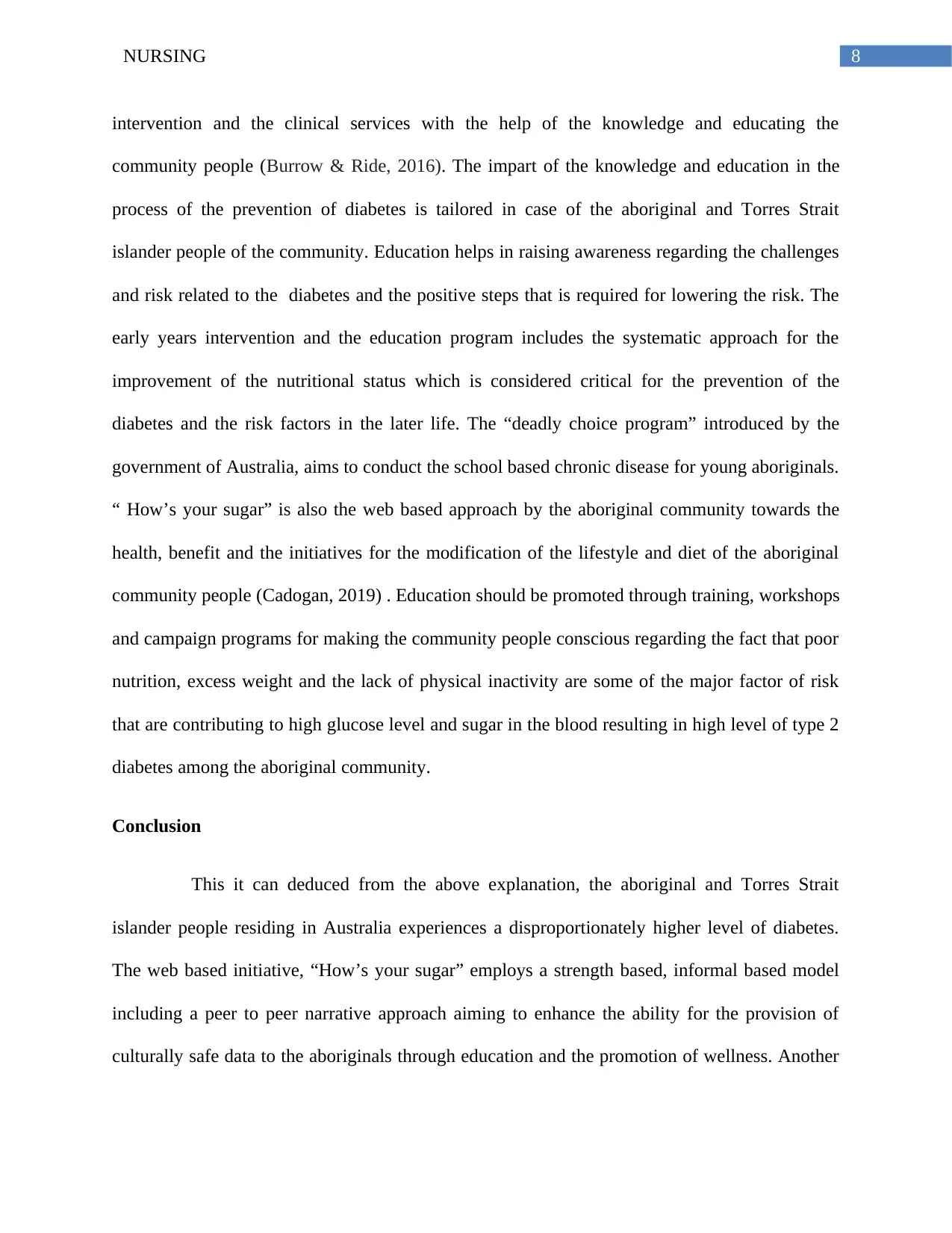
8NURSING
intervention and the clinical services with the help of the knowledge and educating the
community people (Burrow & Ride, 2016). The impart of the knowledge and education in the
process of the prevention of diabetes is tailored in case of the aboriginal and Torres Strait
islander people of the community. Education helps in raising awareness regarding the challenges
and risk related to the diabetes and the positive steps that is required for lowering the risk. The
early years intervention and the education program includes the systematic approach for the
improvement of the nutritional status which is considered critical for the prevention of the
diabetes and the risk factors in the later life. The “deadly choice program” introduced by the
government of Australia, aims to conduct the school based chronic disease for young aboriginals.
“ How’s your sugar” is also the web based approach by the aboriginal community towards the
health, benefit and the initiatives for the modification of the lifestyle and diet of the aboriginal
community people (Cadogan, 2019) . Education should be promoted through training, workshops
and campaign programs for making the community people conscious regarding the fact that poor
nutrition, excess weight and the lack of physical inactivity are some of the major factor of risk
that are contributing to high glucose level and sugar in the blood resulting in high level of type 2
diabetes among the aboriginal community.
Conclusion
This it can deduced from the above explanation, the aboriginal and Torres Strait
islander people residing in Australia experiences a disproportionately higher level of diabetes.
The web based initiative, “How’s your sugar” employs a strength based, informal based model
including a peer to peer narrative approach aiming to enhance the ability for the provision of
culturally safe data to the aboriginals through education and the promotion of wellness. Another
intervention and the clinical services with the help of the knowledge and educating the
community people (Burrow & Ride, 2016). The impart of the knowledge and education in the
process of the prevention of diabetes is tailored in case of the aboriginal and Torres Strait
islander people of the community. Education helps in raising awareness regarding the challenges
and risk related to the diabetes and the positive steps that is required for lowering the risk. The
early years intervention and the education program includes the systematic approach for the
improvement of the nutritional status which is considered critical for the prevention of the
diabetes and the risk factors in the later life. The “deadly choice program” introduced by the
government of Australia, aims to conduct the school based chronic disease for young aboriginals.
“ How’s your sugar” is also the web based approach by the aboriginal community towards the
health, benefit and the initiatives for the modification of the lifestyle and diet of the aboriginal
community people (Cadogan, 2019) . Education should be promoted through training, workshops
and campaign programs for making the community people conscious regarding the fact that poor
nutrition, excess weight and the lack of physical inactivity are some of the major factor of risk
that are contributing to high glucose level and sugar in the blood resulting in high level of type 2
diabetes among the aboriginal community.
Conclusion
This it can deduced from the above explanation, the aboriginal and Torres Strait
islander people residing in Australia experiences a disproportionately higher level of diabetes.
The web based initiative, “How’s your sugar” employs a strength based, informal based model
including a peer to peer narrative approach aiming to enhance the ability for the provision of
culturally safe data to the aboriginals through education and the promotion of wellness. Another
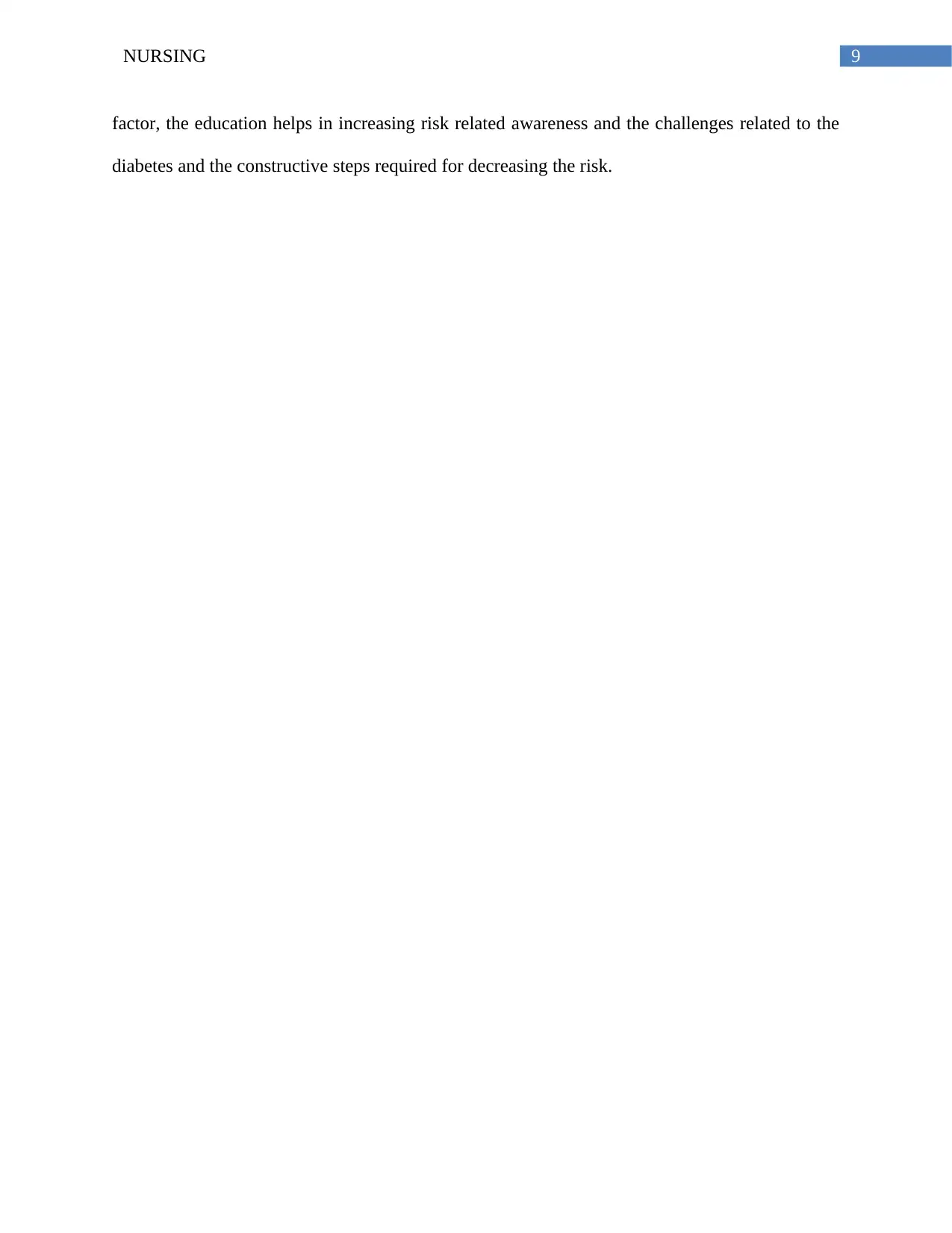
9NURSING
factor, the education helps in increasing risk related awareness and the challenges related to the
diabetes and the constructive steps required for decreasing the risk.
factor, the education helps in increasing risk related awareness and the challenges related to the
diabetes and the constructive steps required for decreasing the risk.
Secure Best Marks with AI Grader
Need help grading? Try our AI Grader for instant feedback on your assignments.
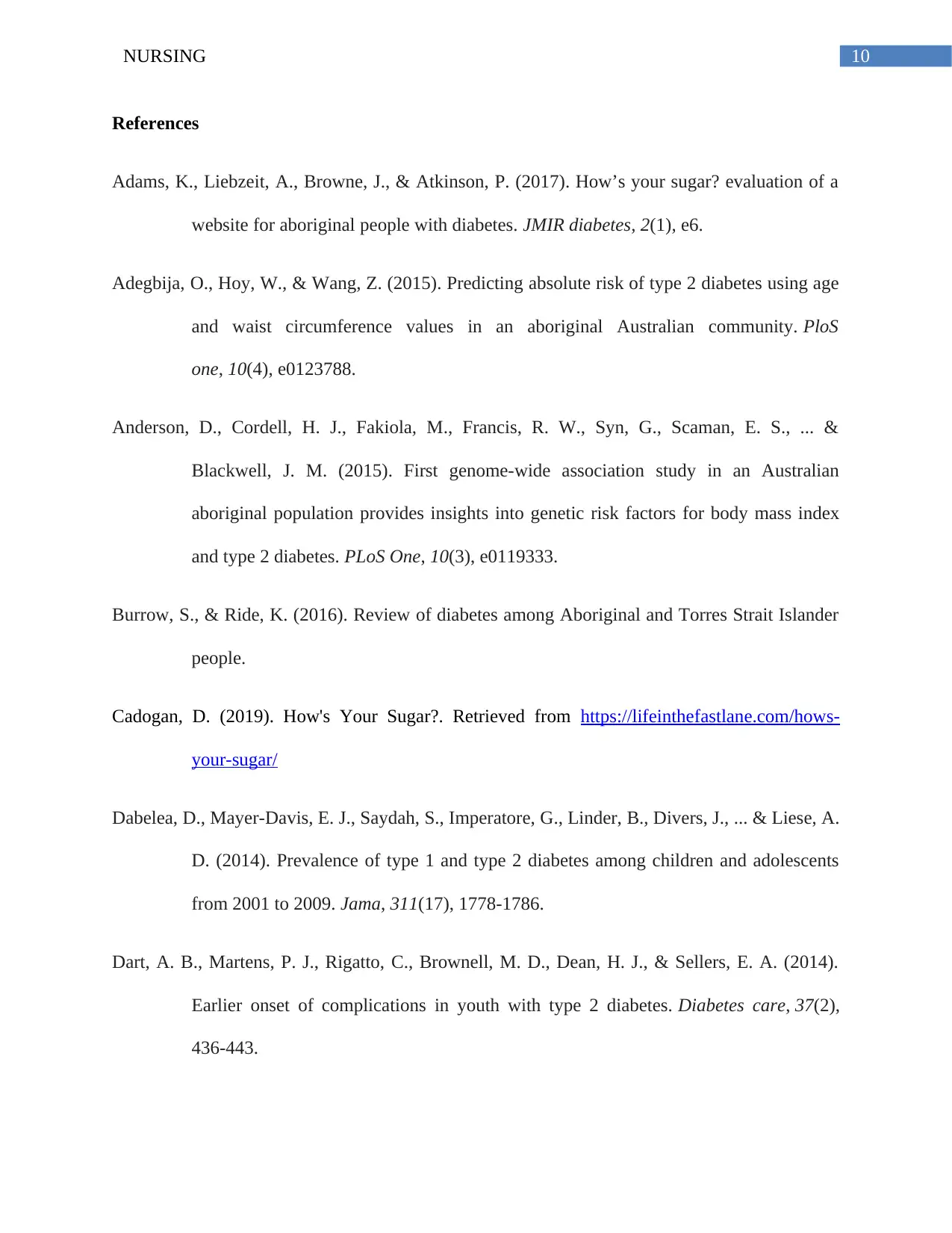
10NURSING
References
Adams, K., Liebzeit, A., Browne, J., & Atkinson, P. (2017). How’s your sugar? evaluation of a
website for aboriginal people with diabetes. JMIR diabetes, 2(1), e6.
Adegbija, O., Hoy, W., & Wang, Z. (2015). Predicting absolute risk of type 2 diabetes using age
and waist circumference values in an aboriginal Australian community. PloS
one, 10(4), e0123788.
Anderson, D., Cordell, H. J., Fakiola, M., Francis, R. W., Syn, G., Scaman, E. S., ... &
Blackwell, J. M. (2015). First genome-wide association study in an Australian
aboriginal population provides insights into genetic risk factors for body mass index
and type 2 diabetes. PLoS One, 10(3), e0119333.
Burrow, S., & Ride, K. (2016). Review of diabetes among Aboriginal and Torres Strait Islander
people.
Cadogan, D. (2019). How's Your Sugar?. Retrieved from https://lifeinthefastlane.com/hows-
your-sugar/
Dabelea, D., Mayer-Davis, E. J., Saydah, S., Imperatore, G., Linder, B., Divers, J., ... & Liese, A.
D. (2014). Prevalence of type 1 and type 2 diabetes among children and adolescents
from 2001 to 2009. Jama, 311(17), 1778-1786.
Dart, A. B., Martens, P. J., Rigatto, C., Brownell, M. D., Dean, H. J., & Sellers, E. A. (2014).
Earlier onset of complications in youth with type 2 diabetes. Diabetes care, 37(2),
436-443.
References
Adams, K., Liebzeit, A., Browne, J., & Atkinson, P. (2017). How’s your sugar? evaluation of a
website for aboriginal people with diabetes. JMIR diabetes, 2(1), e6.
Adegbija, O., Hoy, W., & Wang, Z. (2015). Predicting absolute risk of type 2 diabetes using age
and waist circumference values in an aboriginal Australian community. PloS
one, 10(4), e0123788.
Anderson, D., Cordell, H. J., Fakiola, M., Francis, R. W., Syn, G., Scaman, E. S., ... &
Blackwell, J. M. (2015). First genome-wide association study in an Australian
aboriginal population provides insights into genetic risk factors for body mass index
and type 2 diabetes. PLoS One, 10(3), e0119333.
Burrow, S., & Ride, K. (2016). Review of diabetes among Aboriginal and Torres Strait Islander
people.
Cadogan, D. (2019). How's Your Sugar?. Retrieved from https://lifeinthefastlane.com/hows-
your-sugar/
Dabelea, D., Mayer-Davis, E. J., Saydah, S., Imperatore, G., Linder, B., Divers, J., ... & Liese, A.
D. (2014). Prevalence of type 1 and type 2 diabetes among children and adolescents
from 2001 to 2009. Jama, 311(17), 1778-1786.
Dart, A. B., Martens, P. J., Rigatto, C., Brownell, M. D., Dean, H. J., & Sellers, E. A. (2014).
Earlier onset of complications in youth with type 2 diabetes. Diabetes care, 37(2),
436-443.
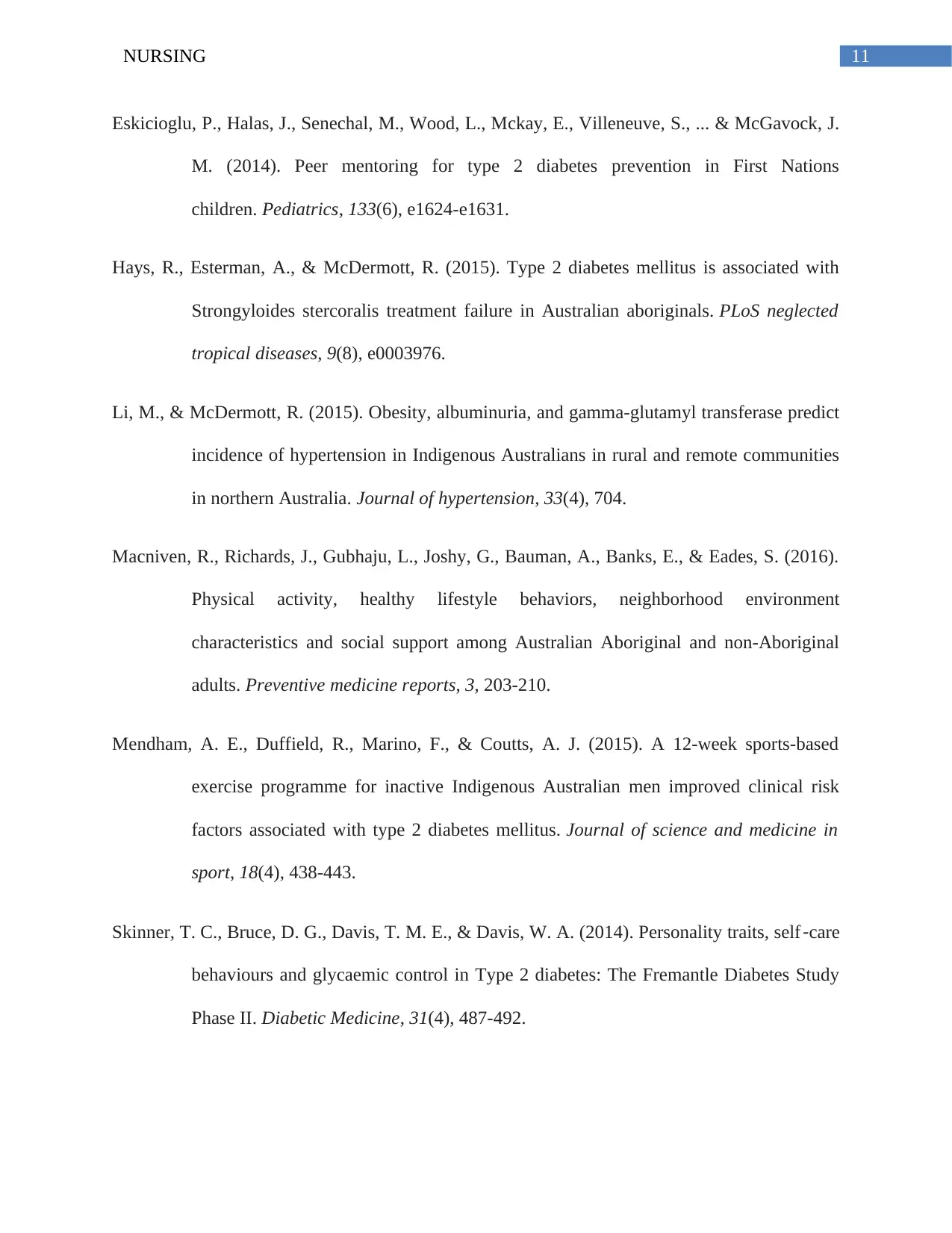
11NURSING
Eskicioglu, P., Halas, J., Senechal, M., Wood, L., Mckay, E., Villeneuve, S., ... & McGavock, J.
M. (2014). Peer mentoring for type 2 diabetes prevention in First Nations
children. Pediatrics, 133(6), e1624-e1631.
Hays, R., Esterman, A., & McDermott, R. (2015). Type 2 diabetes mellitus is associated with
Strongyloides stercoralis treatment failure in Australian aboriginals. PLoS neglected
tropical diseases, 9(8), e0003976.
Li, M., & McDermott, R. (2015). Obesity, albuminuria, and gamma-glutamyl transferase predict
incidence of hypertension in Indigenous Australians in rural and remote communities
in northern Australia. Journal of hypertension, 33(4), 704.
Macniven, R., Richards, J., Gubhaju, L., Joshy, G., Bauman, A., Banks, E., & Eades, S. (2016).
Physical activity, healthy lifestyle behaviors, neighborhood environment
characteristics and social support among Australian Aboriginal and non-Aboriginal
adults. Preventive medicine reports, 3, 203-210.
Mendham, A. E., Duffield, R., Marino, F., & Coutts, A. J. (2015). A 12-week sports-based
exercise programme for inactive Indigenous Australian men improved clinical risk
factors associated with type 2 diabetes mellitus. Journal of science and medicine in
sport, 18(4), 438-443.
Skinner, T. C., Bruce, D. G., Davis, T. M. E., & Davis, W. A. (2014). Personality traits, self ‐care
behaviours and glycaemic control in Type 2 diabetes: The Fremantle Diabetes Study
Phase II. Diabetic Medicine, 31(4), 487-492.
Eskicioglu, P., Halas, J., Senechal, M., Wood, L., Mckay, E., Villeneuve, S., ... & McGavock, J.
M. (2014). Peer mentoring for type 2 diabetes prevention in First Nations
children. Pediatrics, 133(6), e1624-e1631.
Hays, R., Esterman, A., & McDermott, R. (2015). Type 2 diabetes mellitus is associated with
Strongyloides stercoralis treatment failure in Australian aboriginals. PLoS neglected
tropical diseases, 9(8), e0003976.
Li, M., & McDermott, R. (2015). Obesity, albuminuria, and gamma-glutamyl transferase predict
incidence of hypertension in Indigenous Australians in rural and remote communities
in northern Australia. Journal of hypertension, 33(4), 704.
Macniven, R., Richards, J., Gubhaju, L., Joshy, G., Bauman, A., Banks, E., & Eades, S. (2016).
Physical activity, healthy lifestyle behaviors, neighborhood environment
characteristics and social support among Australian Aboriginal and non-Aboriginal
adults. Preventive medicine reports, 3, 203-210.
Mendham, A. E., Duffield, R., Marino, F., & Coutts, A. J. (2015). A 12-week sports-based
exercise programme for inactive Indigenous Australian men improved clinical risk
factors associated with type 2 diabetes mellitus. Journal of science and medicine in
sport, 18(4), 438-443.
Skinner, T. C., Bruce, D. G., Davis, T. M. E., & Davis, W. A. (2014). Personality traits, self ‐care
behaviours and glycaemic control in Type 2 diabetes: The Fremantle Diabetes Study
Phase II. Diabetic Medicine, 31(4), 487-492.
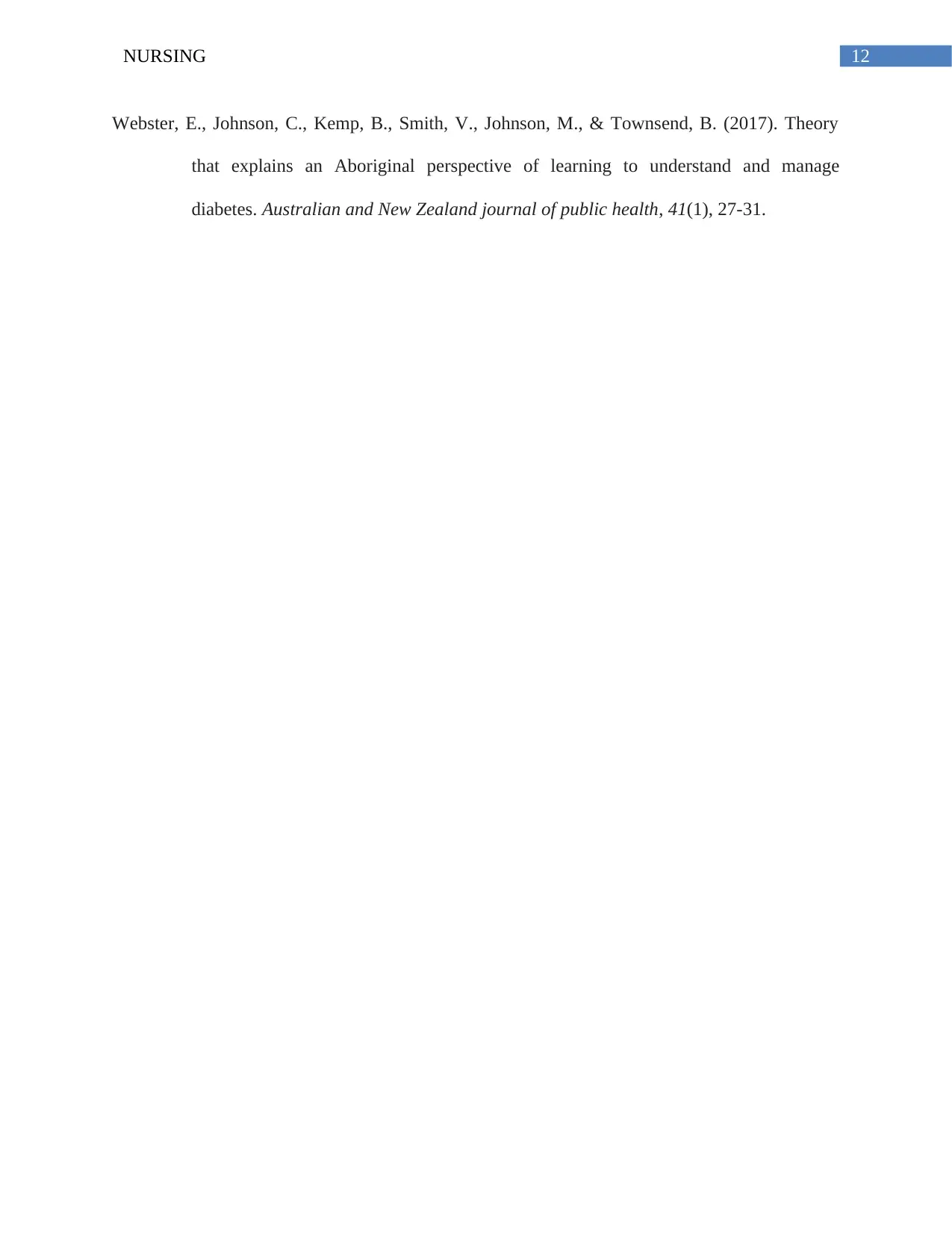
12NURSING
Webster, E., Johnson, C., Kemp, B., Smith, V., Johnson, M., & Townsend, B. (2017). Theory
that explains an Aboriginal perspective of learning to understand and manage
diabetes. Australian and New Zealand journal of public health, 41(1), 27-31.
Webster, E., Johnson, C., Kemp, B., Smith, V., Johnson, M., & Townsend, B. (2017). Theory
that explains an Aboriginal perspective of learning to understand and manage
diabetes. Australian and New Zealand journal of public health, 41(1), 27-31.
1 out of 13
Related Documents
Your All-in-One AI-Powered Toolkit for Academic Success.
+13062052269
info@desklib.com
Available 24*7 on WhatsApp / Email
![[object Object]](/_next/static/media/star-bottom.7253800d.svg)
Unlock your academic potential
© 2024 | Zucol Services PVT LTD | All rights reserved.





